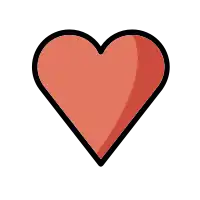As a common symbol throughout typographic history, the heart shape has found its way into many character sets and encodings, including those of Unicode. Some characters depict the shape directly, others reference it in a more derived manner.
History
In the 1990s, NTT DoCoMo released a pager that was aimed at teenagers. The pager was the first of its kind to include the option to send a pictogram as part of the text.[1][2] The pager only had a single pictogram on its options, which was a heart-shaped pictogram. This is thought to be Shigetaka Kurita's first exposure to the use of digital symbols in text form. The pager received rave reviews in Asia which led to other companies in the region to consider using pictograms in the list of text characters. NTT DoCoMo then released another pager aimed at businesspeople, but this time dropped the heart pictogram from the characters on the pager. Following its release, there was an outcry by users that the pictogram was no longer available, and many customers switched to other providers that had now included a heart pictogram in their markup. This led NTT DoCoMo to reverse their decision and include the heart pictogram.[3]
As the emoji became more popular, other heart colours were launched by Unicode. Since then, each heart color has been given its own meaning.[4]
In early 2022, Middle Eastern news publications suggested that sending a Red Heart emoji on WhatsApp in Saudi Arabia could amount to harassment and if convicted, the sender could serve a maximum sentence of two years in jail.[5]
Notable characters
Red heart
The red heart (❤️) emoji is an ideogram that is used in communication to express care and as a romantic or love gesture. It is frequently seen as the most popular emoji in surveys conducted by NTT DoCoMo.[6]
Smiling face with heart-shaped eyes
The Heart Eyes (😍) emoji is to express happiness towards something. The Unicode Consortium listed it as the third most used emoji in 2019, behind the Red Heart and Face with Tears of Joy emoji.[7] It frequently appears in the top 10 lists for the most common emoji.[8]
Encoding
A common emoticon for the heart is <3. In Unicode several heart symbols are available in text format:
| Glyph | Description | HTML code | Alt codes |
|---|---|---|---|
| ❦ | U+2766 FLORAL HEART | ❦ |
|
| ❧ | U+2767 ROTATED FLORAL HEART BULLET | ❧ |
|
| ☙ | U+2619 REVERSED ROTATED FLORAL HEART BULLET | ☙ |
|
| ♡ | U+2661 WHITE HEART SUIT | ♡ or ♡ |
|
| ♥ | U+2665 BLACK HEART SUIT in device default representation | ♥ or ♥ or ♥ |
Alt + 3 |
| ♥︎ | U+2665 BLACK HEART SUIT in explicit plaintext representation | ♥︎ |
|
| ♥️ | U+2665 BLACK HEART SUIT in explicit emoji representation | ♥️ |
|
| ❤ | U+2764 HEAVY BLACK HEART in device default representation | ❤ or ❤ |
|
| ❤︎ | U+2764 HEAVY BLACK HEART in explicit plaintext representation | ❤︎ |
|
| ❤️ | U+2764 HEAVY BLACK HEART in explicit emoji representation | ❤️ |
|
| ❥ | U+2765 ROTATED HEAVY BLACK HEART BULLET | ❥ or ❥ |
|
| ❣ | U+2763 HEAVY HEART EXCLAMATION MARK ORNAMENT | ❣ or ❣ |
And from the Miscellaneous Symbols and Pictographs and Supplemental Symbols and Pictographs ranges associated with emoji:
|
|
In Code page 437, the original character set of the IBM PC, the value of 3 (hexadecimal 03) represents the heart symbol. This value is shared with the non-printing ETX control character, which overrides the glyph in many contexts.
See also
References
- ↑ "WORLDKINGS - Worldkings News - Asia Records Institute (ASRI) – Shigetaka Kurita: World's first designer created emoji sets". Worldkings - World Records Union. Retrieved 2023-04-28.
- ↑ "The Origin Of The Word 'Emoji'". Science Friday. Retrieved 2023-04-28.
- ↑ Mayer, Johanna. "The Origin Of The Word 'Emoji'". Science Friday.
- ↑ Hsieh, Carina; Varina, Rachel (5 August 2021). "The Color of the Heart Emoji You Send Is Seriously Important". Cosmopolitan. Retrieved 16 August 2022.
- ↑ Nasrallah, Tawfiq (13 February 2022). "Sending red heart emojis on WhatsApp 'can land user in jail' in Saudi Arabia". Gulf News. Dubai. Retrieved 16 August 2022.
- ↑ Kraus, Rachel (February 14, 2020). "Heart emoji, ranked". Mashable.
- ↑ "Frequency of Emoji Use 2019". Unicode.
- ↑ Silva, Christianna (February 9, 2022). "Tears of joy emoji might be experiencing a renaissance". Mashable.




